Macroeconomic Policies and Their Impact on Economic Growth and Poverty
VerifiedAdded on 2023/06/07
|11
|3810
|376
Report
AI Summary
This report delves into the realm of macroeconomic policies, exploring how governments utilize fiscal and monetary tools to address real-world economic challenges, such as achieving sustainable economic growth and alleviating poverty. It begins by establishing the fundamental principles of macroeconomics, differentiating between micro and macro levels of economic analysis. The report then examines fiscal policy, detailing how government spending and taxation influence the Gross Domestic Product (GDP) and its components. It also explores expansionary and contractionary fiscal policies, illustrating their effects on income, inflation, and the overall economy. Furthermore, the report investigates monetary policy, focusing on the role of central banks in setting interest rates and managing the money supply through open market operations. It analyzes the impact of both contractionary and expansionary monetary policies on consumption, investment, and GDP. The report then shifts its focus to China, analyzing the country's implementation of fiscal and monetary policies to sustain rapid economic growth and reduce poverty, discussing the mixed economy approach and the remarkable achievements in poverty reduction since the 1980s. The analysis includes the role of government spending, tax breaks, and central bank policies to stimulate the economy and manage deficits. The report also touches upon the impact of these policies on the labor market and income distribution.
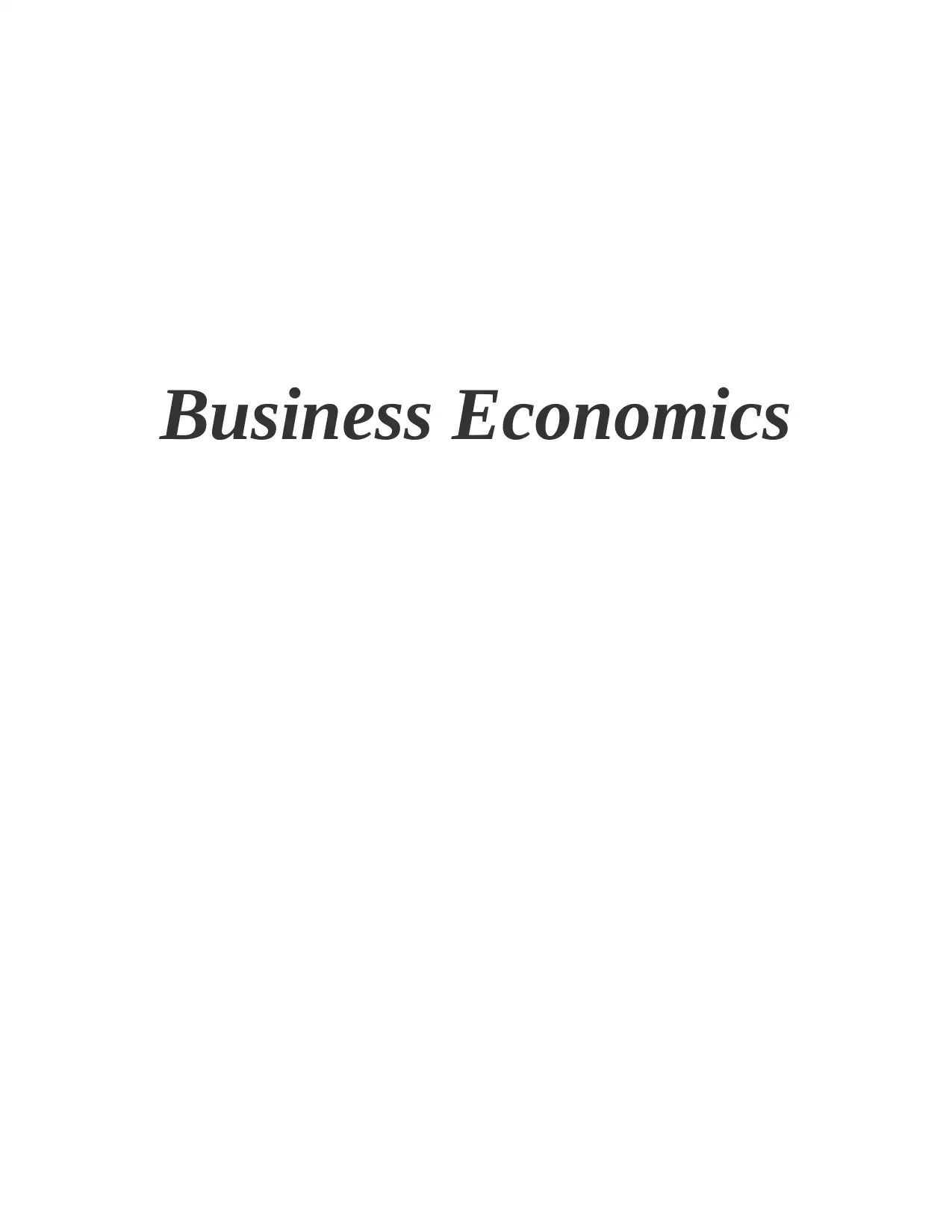
Business Economics
Paraphrase This Document
Need a fresh take? Get an instant paraphrase of this document with our AI Paraphraser
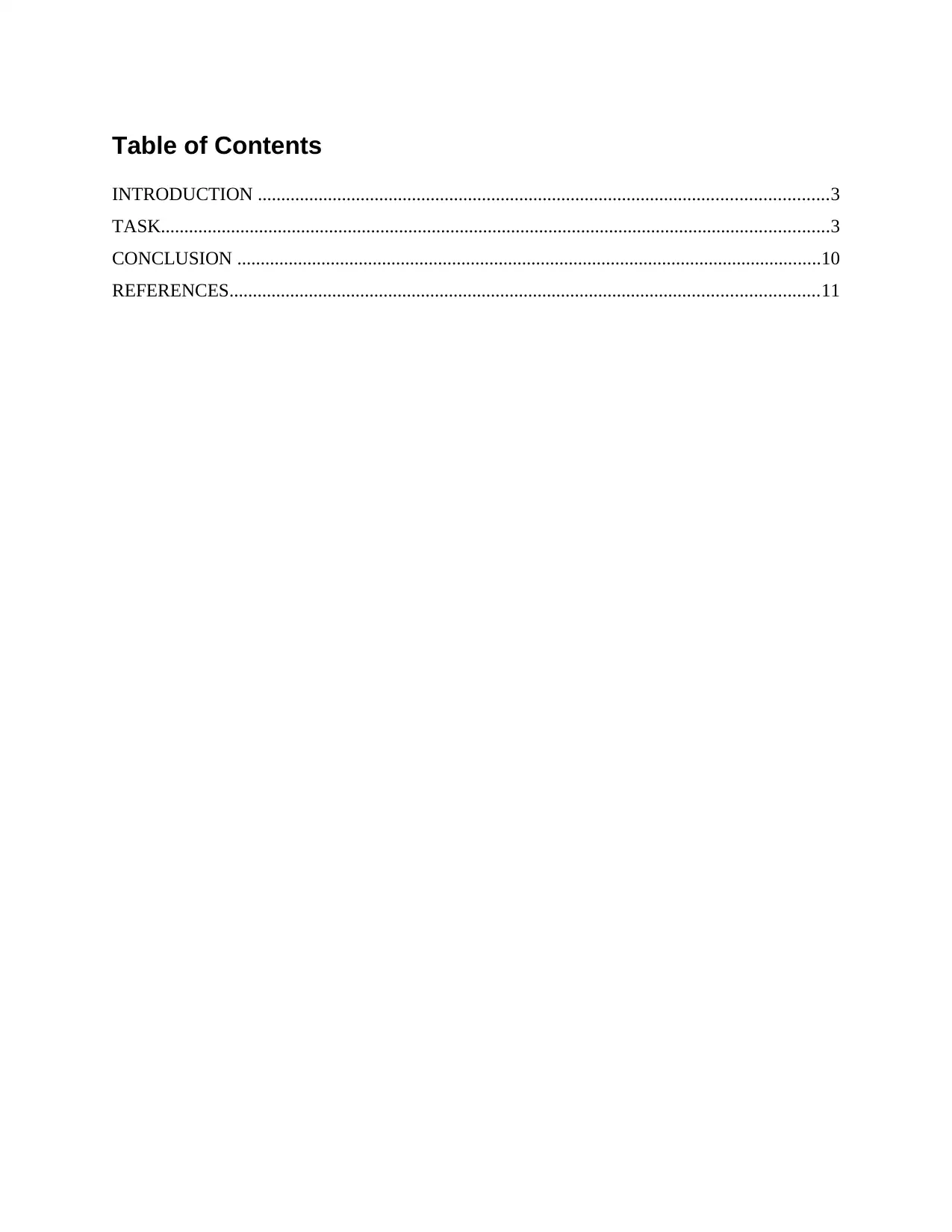
Table of Contents
INTRODUCTION ..........................................................................................................................3
TASK...............................................................................................................................................3
CONCLUSION .............................................................................................................................10
REFERENCES..............................................................................................................................11
INTRODUCTION ..........................................................................................................................3
TASK...............................................................................................................................................3
CONCLUSION .............................................................................................................................10
REFERENCES..............................................................................................................................11
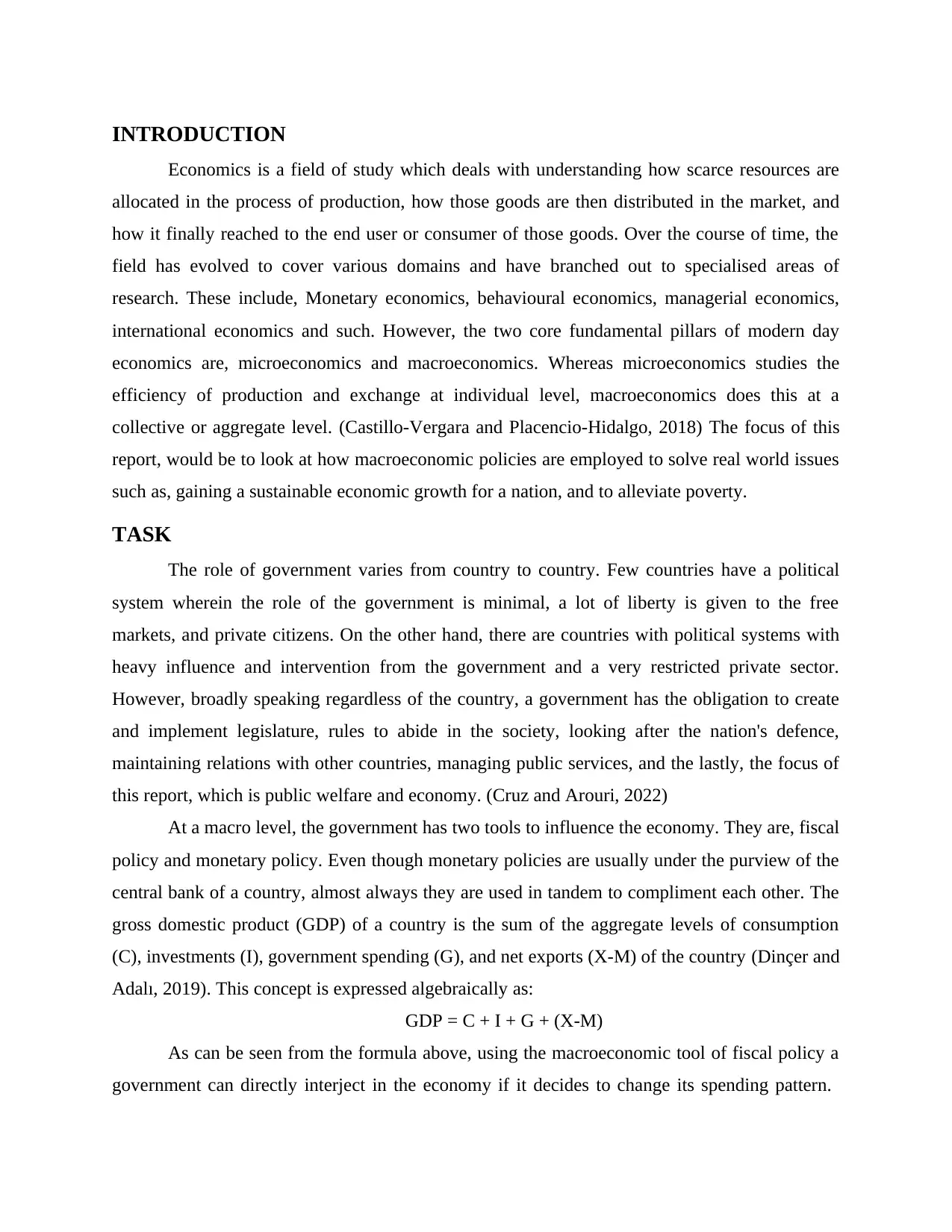
INTRODUCTION
Economics is a field of study which deals with understanding how scarce resources are
allocated in the process of production, how those goods are then distributed in the market, and
how it finally reached to the end user or consumer of those goods. Over the course of time, the
field has evolved to cover various domains and have branched out to specialised areas of
research. These include, Monetary economics, behavioural economics, managerial economics,
international economics and such. However, the two core fundamental pillars of modern day
economics are, microeconomics and macroeconomics. Whereas microeconomics studies the
efficiency of production and exchange at individual level, macroeconomics does this at a
collective or aggregate level. (Castillo-Vergara and Placencio-Hidalgo, 2018) The focus of this
report, would be to look at how macroeconomic policies are employed to solve real world issues
such as, gaining a sustainable economic growth for a nation, and to alleviate poverty.
TASK
The role of government varies from country to country. Few countries have a political
system wherein the role of the government is minimal, a lot of liberty is given to the free
markets, and private citizens. On the other hand, there are countries with political systems with
heavy influence and intervention from the government and a very restricted private sector.
However, broadly speaking regardless of the country, a government has the obligation to create
and implement legislature, rules to abide in the society, looking after the nation's defence,
maintaining relations with other countries, managing public services, and the lastly, the focus of
this report, which is public welfare and economy. (Cruz and Arouri, 2022)
At a macro level, the government has two tools to influence the economy. They are, fiscal
policy and monetary policy. Even though monetary policies are usually under the purview of the
central bank of a country, almost always they are used in tandem to compliment each other. The
gross domestic product (GDP) of a country is the sum of the aggregate levels of consumption
(C), investments (I), government spending (G), and net exports (X-M) of the country (Dinçer and
Adalı, 2019). This concept is expressed algebraically as:
GDP = C + I + G + (X-M)
As can be seen from the formula above, using the macroeconomic tool of fiscal policy a
government can directly interject in the economy if it decides to change its spending pattern.
Economics is a field of study which deals with understanding how scarce resources are
allocated in the process of production, how those goods are then distributed in the market, and
how it finally reached to the end user or consumer of those goods. Over the course of time, the
field has evolved to cover various domains and have branched out to specialised areas of
research. These include, Monetary economics, behavioural economics, managerial economics,
international economics and such. However, the two core fundamental pillars of modern day
economics are, microeconomics and macroeconomics. Whereas microeconomics studies the
efficiency of production and exchange at individual level, macroeconomics does this at a
collective or aggregate level. (Castillo-Vergara and Placencio-Hidalgo, 2018) The focus of this
report, would be to look at how macroeconomic policies are employed to solve real world issues
such as, gaining a sustainable economic growth for a nation, and to alleviate poverty.
TASK
The role of government varies from country to country. Few countries have a political
system wherein the role of the government is minimal, a lot of liberty is given to the free
markets, and private citizens. On the other hand, there are countries with political systems with
heavy influence and intervention from the government and a very restricted private sector.
However, broadly speaking regardless of the country, a government has the obligation to create
and implement legislature, rules to abide in the society, looking after the nation's defence,
maintaining relations with other countries, managing public services, and the lastly, the focus of
this report, which is public welfare and economy. (Cruz and Arouri, 2022)
At a macro level, the government has two tools to influence the economy. They are, fiscal
policy and monetary policy. Even though monetary policies are usually under the purview of the
central bank of a country, almost always they are used in tandem to compliment each other. The
gross domestic product (GDP) of a country is the sum of the aggregate levels of consumption
(C), investments (I), government spending (G), and net exports (X-M) of the country (Dinçer and
Adalı, 2019). This concept is expressed algebraically as:
GDP = C + I + G + (X-M)
As can be seen from the formula above, using the macroeconomic tool of fiscal policy a
government can directly interject in the economy if it decides to change its spending pattern.
⊘ This is a preview!⊘
Do you want full access?
Subscribe today to unlock all pages.

Trusted by 1+ million students worldwide
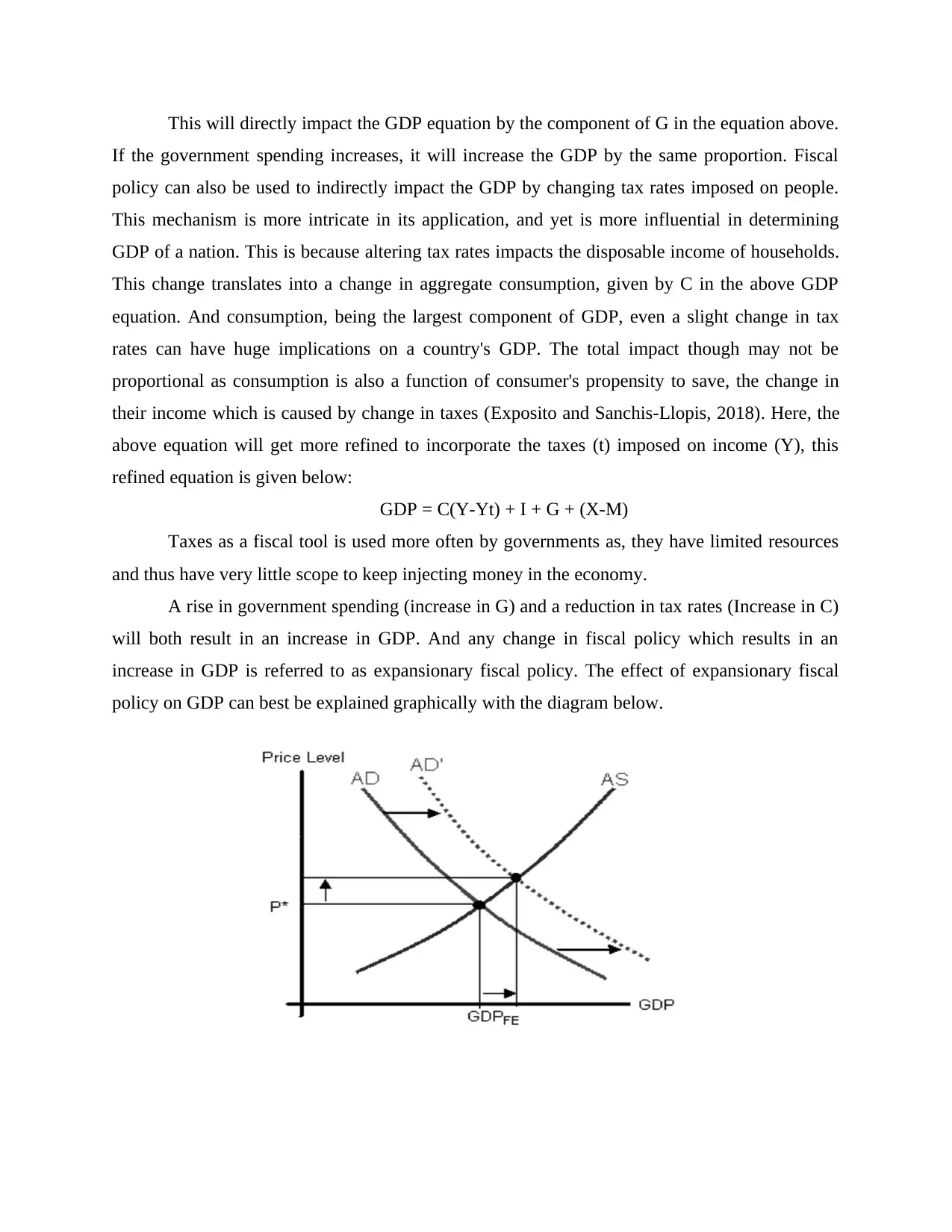
This will directly impact the GDP equation by the component of G in the equation above.
If the government spending increases, it will increase the GDP by the same proportion. Fiscal
policy can also be used to indirectly impact the GDP by changing tax rates imposed on people.
This mechanism is more intricate in its application, and yet is more influential in determining
GDP of a nation. This is because altering tax rates impacts the disposable income of households.
This change translates into a change in aggregate consumption, given by C in the above GDP
equation. And consumption, being the largest component of GDP, even a slight change in tax
rates can have huge implications on a country's GDP. The total impact though may not be
proportional as consumption is also a function of consumer's propensity to save, the change in
their income which is caused by change in taxes (Exposito and Sanchis-Llopis, 2018). Here, the
above equation will get more refined to incorporate the taxes (t) imposed on income (Y), this
refined equation is given below:
GDP = C(Y-Yt) + I + G + (X-M)
Taxes as a fiscal tool is used more often by governments as, they have limited resources
and thus have very little scope to keep injecting money in the economy.
A rise in government spending (increase in G) and a reduction in tax rates (Increase in C)
will both result in an increase in GDP. And any change in fiscal policy which results in an
increase in GDP is referred to as expansionary fiscal policy. The effect of expansionary fiscal
policy on GDP can best be explained graphically with the diagram below.
If the government spending increases, it will increase the GDP by the same proportion. Fiscal
policy can also be used to indirectly impact the GDP by changing tax rates imposed on people.
This mechanism is more intricate in its application, and yet is more influential in determining
GDP of a nation. This is because altering tax rates impacts the disposable income of households.
This change translates into a change in aggregate consumption, given by C in the above GDP
equation. And consumption, being the largest component of GDP, even a slight change in tax
rates can have huge implications on a country's GDP. The total impact though may not be
proportional as consumption is also a function of consumer's propensity to save, the change in
their income which is caused by change in taxes (Exposito and Sanchis-Llopis, 2018). Here, the
above equation will get more refined to incorporate the taxes (t) imposed on income (Y), this
refined equation is given below:
GDP = C(Y-Yt) + I + G + (X-M)
Taxes as a fiscal tool is used more often by governments as, they have limited resources
and thus have very little scope to keep injecting money in the economy.
A rise in government spending (increase in G) and a reduction in tax rates (Increase in C)
will both result in an increase in GDP. And any change in fiscal policy which results in an
increase in GDP is referred to as expansionary fiscal policy. The effect of expansionary fiscal
policy on GDP can best be explained graphically with the diagram below.
Paraphrase This Document
Need a fresh take? Get an instant paraphrase of this document with our AI Paraphraser
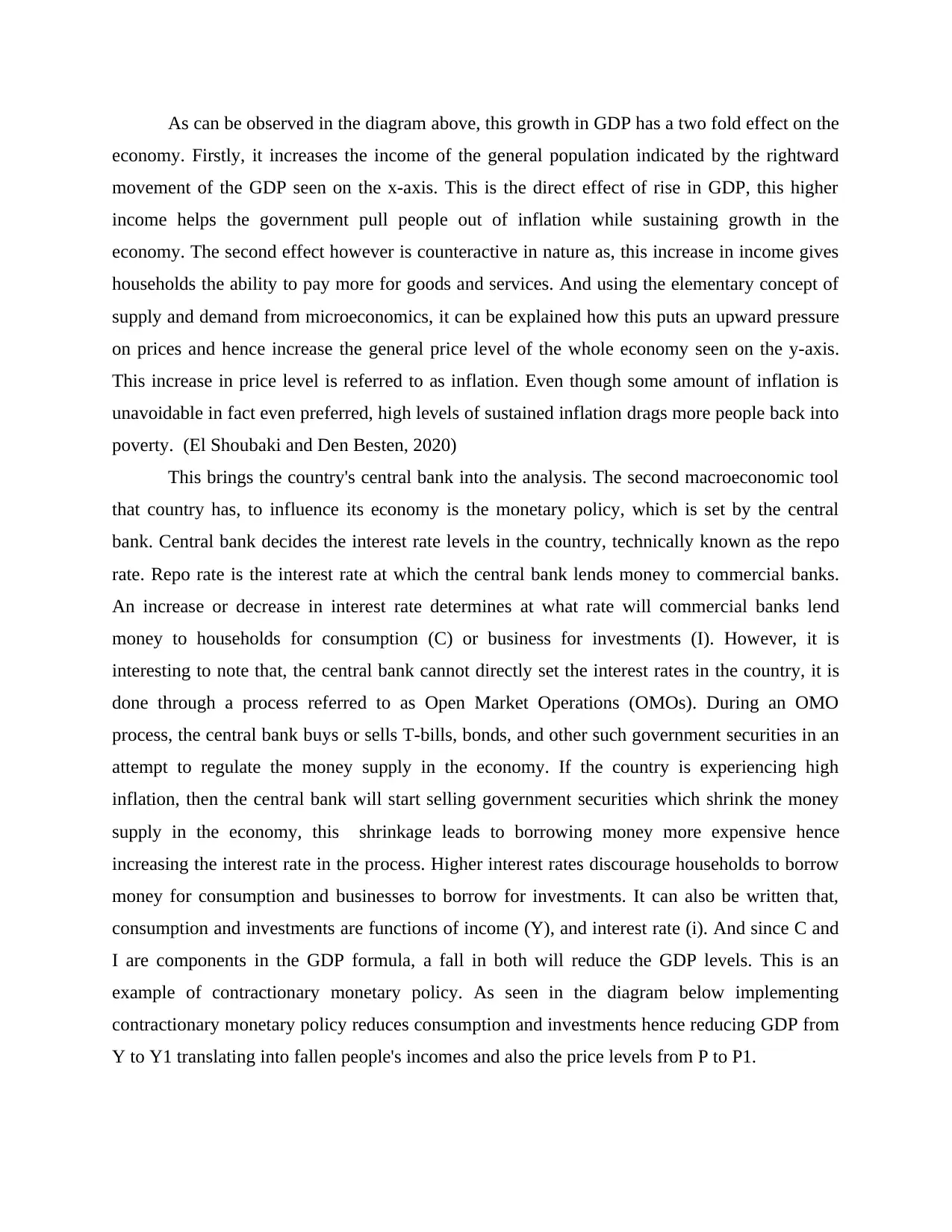
As can be observed in the diagram above, this growth in GDP has a two fold effect on the
economy. Firstly, it increases the income of the general population indicated by the rightward
movement of the GDP seen on the x-axis. This is the direct effect of rise in GDP, this higher
income helps the government pull people out of inflation while sustaining growth in the
economy. The second effect however is counteractive in nature as, this increase in income gives
households the ability to pay more for goods and services. And using the elementary concept of
supply and demand from microeconomics, it can be explained how this puts an upward pressure
on prices and hence increase the general price level of the whole economy seen on the y-axis.
This increase in price level is referred to as inflation. Even though some amount of inflation is
unavoidable in fact even preferred, high levels of sustained inflation drags more people back into
poverty. (El Shoubaki and Den Besten, 2020)
This brings the country's central bank into the analysis. The second macroeconomic tool
that country has, to influence its economy is the monetary policy, which is set by the central
bank. Central bank decides the interest rate levels in the country, technically known as the repo
rate. Repo rate is the interest rate at which the central bank lends money to commercial banks.
An increase or decrease in interest rate determines at what rate will commercial banks lend
money to households for consumption (C) or business for investments (I). However, it is
interesting to note that, the central bank cannot directly set the interest rates in the country, it is
done through a process referred to as Open Market Operations (OMOs). During an OMO
process, the central bank buys or sells T-bills, bonds, and other such government securities in an
attempt to regulate the money supply in the economy. If the country is experiencing high
inflation, then the central bank will start selling government securities which shrink the money
supply in the economy, this shrinkage leads to borrowing money more expensive hence
increasing the interest rate in the process. Higher interest rates discourage households to borrow
money for consumption and businesses to borrow for investments. It can also be written that,
consumption and investments are functions of income (Y), and interest rate (i). And since C and
I are components in the GDP formula, a fall in both will reduce the GDP levels. This is an
example of contractionary monetary policy. As seen in the diagram below implementing
contractionary monetary policy reduces consumption and investments hence reducing GDP from
Y to Y1 translating into fallen people's incomes and also the price levels from P to P1.
economy. Firstly, it increases the income of the general population indicated by the rightward
movement of the GDP seen on the x-axis. This is the direct effect of rise in GDP, this higher
income helps the government pull people out of inflation while sustaining growth in the
economy. The second effect however is counteractive in nature as, this increase in income gives
households the ability to pay more for goods and services. And using the elementary concept of
supply and demand from microeconomics, it can be explained how this puts an upward pressure
on prices and hence increase the general price level of the whole economy seen on the y-axis.
This increase in price level is referred to as inflation. Even though some amount of inflation is
unavoidable in fact even preferred, high levels of sustained inflation drags more people back into
poverty. (El Shoubaki and Den Besten, 2020)
This brings the country's central bank into the analysis. The second macroeconomic tool
that country has, to influence its economy is the monetary policy, which is set by the central
bank. Central bank decides the interest rate levels in the country, technically known as the repo
rate. Repo rate is the interest rate at which the central bank lends money to commercial banks.
An increase or decrease in interest rate determines at what rate will commercial banks lend
money to households for consumption (C) or business for investments (I). However, it is
interesting to note that, the central bank cannot directly set the interest rates in the country, it is
done through a process referred to as Open Market Operations (OMOs). During an OMO
process, the central bank buys or sells T-bills, bonds, and other such government securities in an
attempt to regulate the money supply in the economy. If the country is experiencing high
inflation, then the central bank will start selling government securities which shrink the money
supply in the economy, this shrinkage leads to borrowing money more expensive hence
increasing the interest rate in the process. Higher interest rates discourage households to borrow
money for consumption and businesses to borrow for investments. It can also be written that,
consumption and investments are functions of income (Y), and interest rate (i). And since C and
I are components in the GDP formula, a fall in both will reduce the GDP levels. This is an
example of contractionary monetary policy. As seen in the diagram below implementing
contractionary monetary policy reduces consumption and investments hence reducing GDP from
Y to Y1 translating into fallen people's incomes and also the price levels from P to P1.
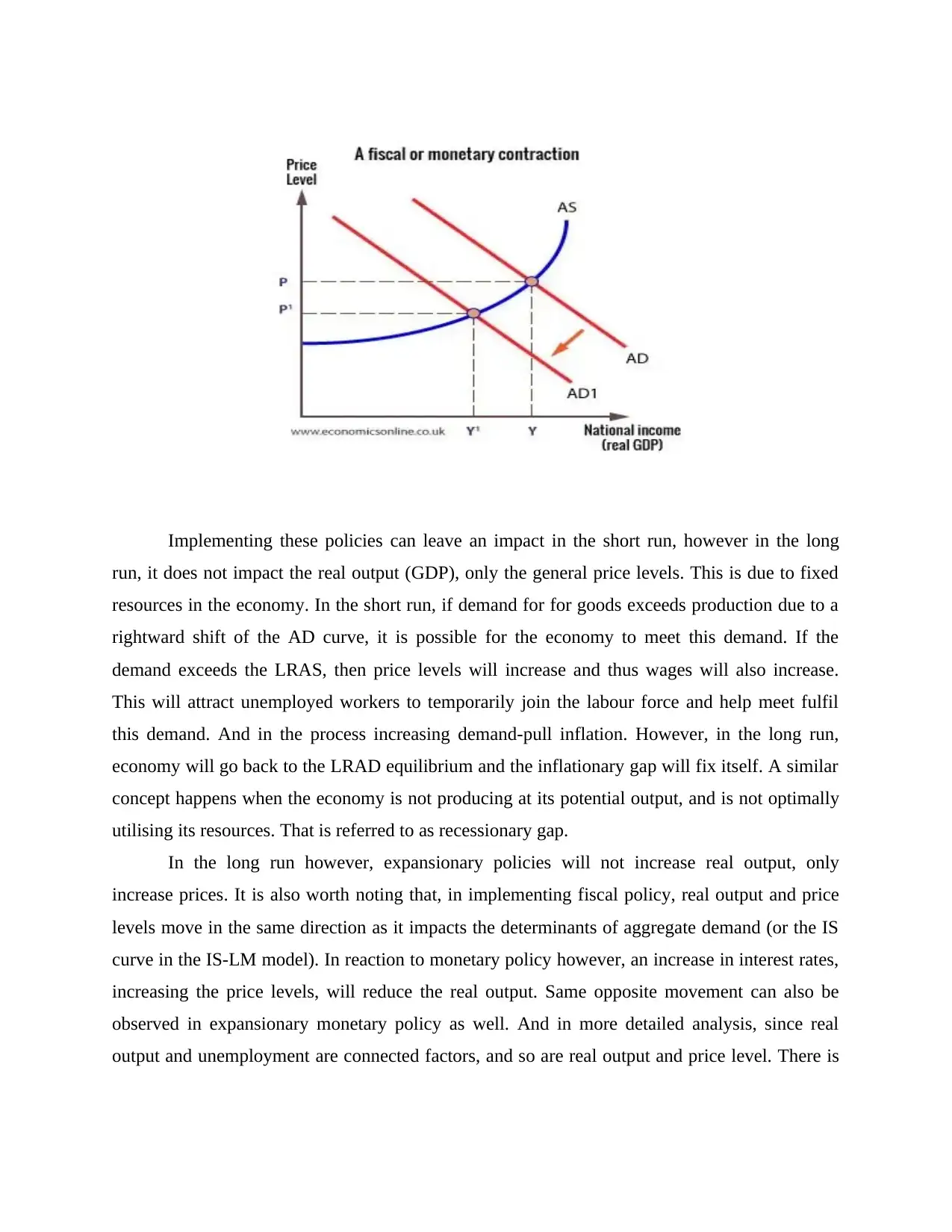
Implementing these policies can leave an impact in the short run, however in the long
run, it does not impact the real output (GDP), only the general price levels. This is due to fixed
resources in the economy. In the short run, if demand for for goods exceeds production due to a
rightward shift of the AD curve, it is possible for the economy to meet this demand. If the
demand exceeds the LRAS, then price levels will increase and thus wages will also increase.
This will attract unemployed workers to temporarily join the labour force and help meet fulfil
this demand. And in the process increasing demand-pull inflation. However, in the long run,
economy will go back to the LRAD equilibrium and the inflationary gap will fix itself. A similar
concept happens when the economy is not producing at its potential output, and is not optimally
utilising its resources. That is referred to as recessionary gap.
In the long run however, expansionary policies will not increase real output, only
increase prices. It is also worth noting that, in implementing fiscal policy, real output and price
levels move in the same direction as it impacts the determinants of aggregate demand (or the IS
curve in the IS-LM model). In reaction to monetary policy however, an increase in interest rates,
increasing the price levels, will reduce the real output. Same opposite movement can also be
observed in expansionary monetary policy as well. And in more detailed analysis, since real
output and unemployment are connected factors, and so are real output and price level. There is
run, it does not impact the real output (GDP), only the general price levels. This is due to fixed
resources in the economy. In the short run, if demand for for goods exceeds production due to a
rightward shift of the AD curve, it is possible for the economy to meet this demand. If the
demand exceeds the LRAS, then price levels will increase and thus wages will also increase.
This will attract unemployed workers to temporarily join the labour force and help meet fulfil
this demand. And in the process increasing demand-pull inflation. However, in the long run,
economy will go back to the LRAD equilibrium and the inflationary gap will fix itself. A similar
concept happens when the economy is not producing at its potential output, and is not optimally
utilising its resources. That is referred to as recessionary gap.
In the long run however, expansionary policies will not increase real output, only
increase prices. It is also worth noting that, in implementing fiscal policy, real output and price
levels move in the same direction as it impacts the determinants of aggregate demand (or the IS
curve in the IS-LM model). In reaction to monetary policy however, an increase in interest rates,
increasing the price levels, will reduce the real output. Same opposite movement can also be
observed in expansionary monetary policy as well. And in more detailed analysis, since real
output and unemployment are connected factors, and so are real output and price level. There is
⊘ This is a preview!⊘
Do you want full access?
Subscribe today to unlock all pages.

Trusted by 1+ million students worldwide
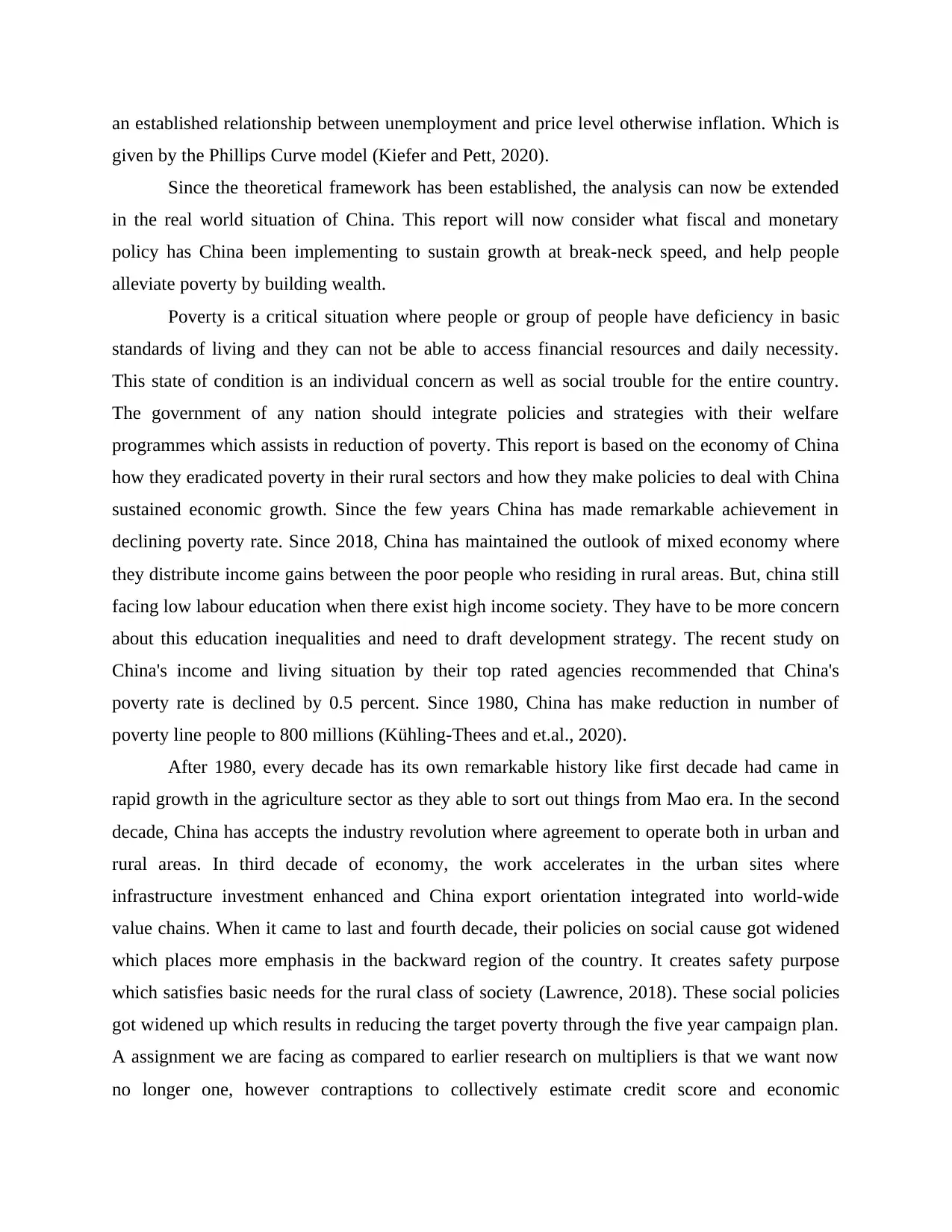
an established relationship between unemployment and price level otherwise inflation. Which is
given by the Phillips Curve model (Kiefer and Pett, 2020).
Since the theoretical framework has been established, the analysis can now be extended
in the real world situation of China. This report will now consider what fiscal and monetary
policy has China been implementing to sustain growth at break-neck speed, and help people
alleviate poverty by building wealth.
Poverty is a critical situation where people or group of people have deficiency in basic
standards of living and they can not be able to access financial resources and daily necessity.
This state of condition is an individual concern as well as social trouble for the entire country.
The government of any nation should integrate policies and strategies with their welfare
programmes which assists in reduction of poverty. This report is based on the economy of China
how they eradicated poverty in their rural sectors and how they make policies to deal with China
sustained economic growth. Since the few years China has made remarkable achievement in
declining poverty rate. Since 2018, China has maintained the outlook of mixed economy where
they distribute income gains between the poor people who residing in rural areas. But, china still
facing low labour education when there exist high income society. They have to be more concern
about this education inequalities and need to draft development strategy. The recent study on
China's income and living situation by their top rated agencies recommended that China's
poverty rate is declined by 0.5 percent. Since 1980, China has make reduction in number of
poverty line people to 800 millions (Kühling-Thees and et.al., 2020).
After 1980, every decade has its own remarkable history like first decade had came in
rapid growth in the agriculture sector as they able to sort out things from Mao era. In the second
decade, China has accepts the industry revolution where agreement to operate both in urban and
rural areas. In third decade of economy, the work accelerates in the urban sites where
infrastructure investment enhanced and China export orientation integrated into world-wide
value chains. When it came to last and fourth decade, their policies on social cause got widened
which places more emphasis in the backward region of the country. It creates safety purpose
which satisfies basic needs for the rural class of society (Lawrence, 2018). These social policies
got widened up which results in reducing the target poverty through the five year campaign plan.
A assignment we are facing as compared to earlier research on multipliers is that we want now
no longer one, however contraptions to collectively estimate credit score and economic
given by the Phillips Curve model (Kiefer and Pett, 2020).
Since the theoretical framework has been established, the analysis can now be extended
in the real world situation of China. This report will now consider what fiscal and monetary
policy has China been implementing to sustain growth at break-neck speed, and help people
alleviate poverty by building wealth.
Poverty is a critical situation where people or group of people have deficiency in basic
standards of living and they can not be able to access financial resources and daily necessity.
This state of condition is an individual concern as well as social trouble for the entire country.
The government of any nation should integrate policies and strategies with their welfare
programmes which assists in reduction of poverty. This report is based on the economy of China
how they eradicated poverty in their rural sectors and how they make policies to deal with China
sustained economic growth. Since the few years China has made remarkable achievement in
declining poverty rate. Since 2018, China has maintained the outlook of mixed economy where
they distribute income gains between the poor people who residing in rural areas. But, china still
facing low labour education when there exist high income society. They have to be more concern
about this education inequalities and need to draft development strategy. The recent study on
China's income and living situation by their top rated agencies recommended that China's
poverty rate is declined by 0.5 percent. Since 1980, China has make reduction in number of
poverty line people to 800 millions (Kühling-Thees and et.al., 2020).
After 1980, every decade has its own remarkable history like first decade had came in
rapid growth in the agriculture sector as they able to sort out things from Mao era. In the second
decade, China has accepts the industry revolution where agreement to operate both in urban and
rural areas. In third decade of economy, the work accelerates in the urban sites where
infrastructure investment enhanced and China export orientation integrated into world-wide
value chains. When it came to last and fourth decade, their policies on social cause got widened
which places more emphasis in the backward region of the country. It creates safety purpose
which satisfies basic needs for the rural class of society (Lawrence, 2018). These social policies
got widened up which results in reducing the target poverty through the five year campaign plan.
A assignment we are facing as compared to earlier research on multipliers is that we want now
no longer one, however contraptions to collectively estimate credit score and economic
Paraphrase This Document
Need a fresh take? Get an instant paraphrase of this document with our AI Paraphraser
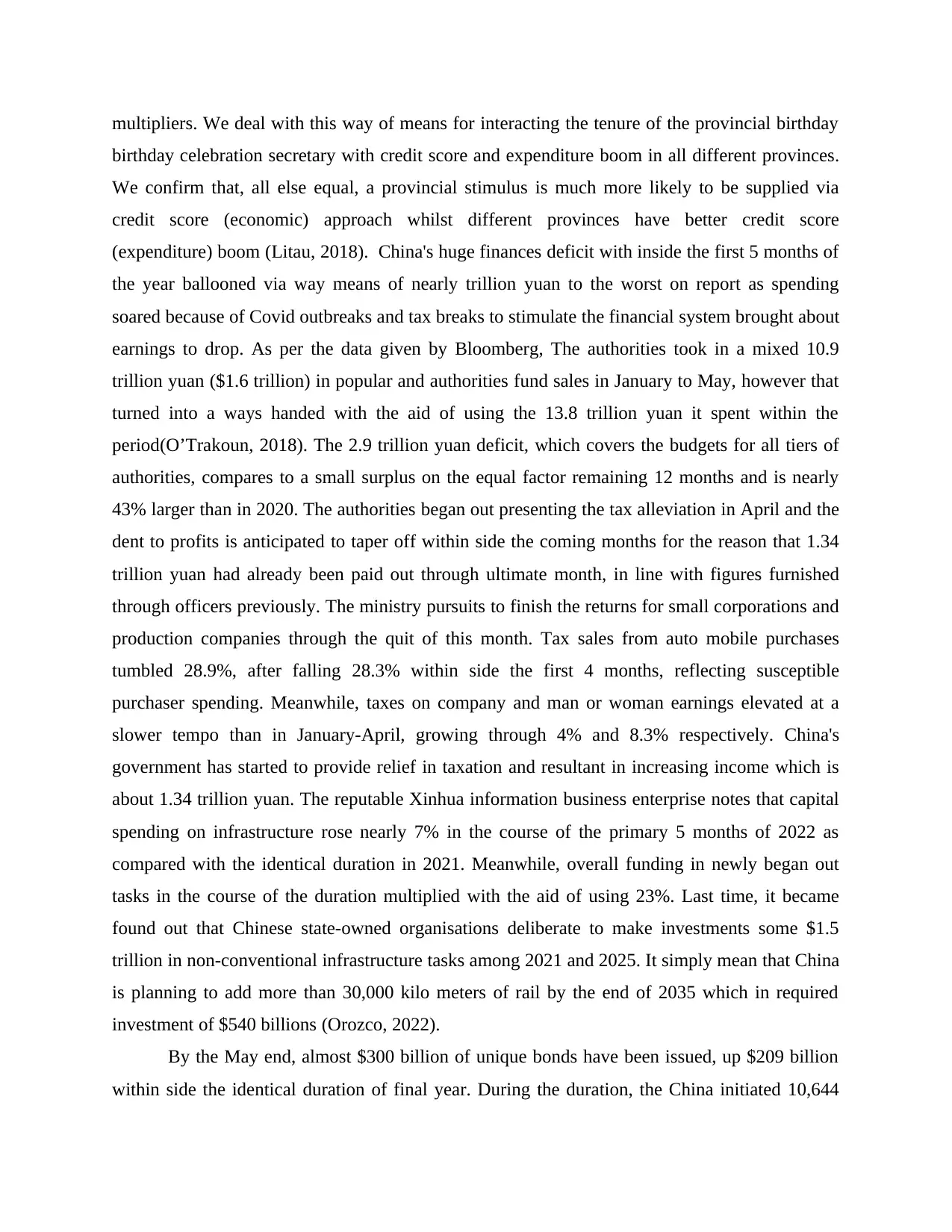
multipliers. We deal with this way of means for interacting the tenure of the provincial birthday
birthday celebration secretary with credit score and expenditure boom in all different provinces.
We confirm that, all else equal, a provincial stimulus is much more likely to be supplied via
credit score (economic) approach whilst different provinces have better credit score
(expenditure) boom (Litau, 2018). China's huge finances deficit with inside the first 5 months of
the year ballooned via way means of nearly trillion yuan to the worst on report as spending
soared because of Covid outbreaks and tax breaks to stimulate the financial system brought about
earnings to drop. As per the data given by Bloomberg, The authorities took in a mixed 10.9
trillion yuan ($1.6 trillion) in popular and authorities fund sales in January to May, however that
turned into a ways handed with the aid of using the 13.8 trillion yuan it spent within the
period(O’Trakoun, 2018). The 2.9 trillion yuan deficit, which covers the budgets for all tiers of
authorities, compares to a small surplus on the equal factor remaining 12 months and is nearly
43% larger than in 2020. The authorities began out presenting the tax alleviation in April and the
dent to profits is anticipated to taper off within side the coming months for the reason that 1.34
trillion yuan had already been paid out through ultimate month, in line with figures furnished
through officers previously. The ministry pursuits to finish the returns for small corporations and
production companies through the quit of this month. Tax sales from auto mobile purchases
tumbled 28.9%, after falling 28.3% within side the first 4 months, reflecting susceptible
purchaser spending. Meanwhile, taxes on company and man or woman earnings elevated at a
slower tempo than in January-April, growing through 4% and 8.3% respectively. China's
government has started to provide relief in taxation and resultant in increasing income which is
about 1.34 trillion yuan. The reputable Xinhua information business enterprise notes that capital
spending on infrastructure rose nearly 7% in the course of the primary 5 months of 2022 as
compared with the identical duration in 2021. Meanwhile, overall funding in newly began out
tasks in the course of the duration multiplied with the aid of using 23%. Last time, it became
found out that Chinese state-owned organisations deliberate to make investments some $1.5
trillion in non-conventional infrastructure tasks among 2021 and 2025. It simply mean that China
is planning to add more than 30,000 kilo meters of rail by the end of 2035 which in required
investment of $540 billions (Orozco, 2022).
By the May end, almost $300 billion of unique bonds have been issued, up $209 billion
within side the identical duration of final year. During the duration, the China initiated 10,644
birthday celebration secretary with credit score and expenditure boom in all different provinces.
We confirm that, all else equal, a provincial stimulus is much more likely to be supplied via
credit score (economic) approach whilst different provinces have better credit score
(expenditure) boom (Litau, 2018). China's huge finances deficit with inside the first 5 months of
the year ballooned via way means of nearly trillion yuan to the worst on report as spending
soared because of Covid outbreaks and tax breaks to stimulate the financial system brought about
earnings to drop. As per the data given by Bloomberg, The authorities took in a mixed 10.9
trillion yuan ($1.6 trillion) in popular and authorities fund sales in January to May, however that
turned into a ways handed with the aid of using the 13.8 trillion yuan it spent within the
period(O’Trakoun, 2018). The 2.9 trillion yuan deficit, which covers the budgets for all tiers of
authorities, compares to a small surplus on the equal factor remaining 12 months and is nearly
43% larger than in 2020. The authorities began out presenting the tax alleviation in April and the
dent to profits is anticipated to taper off within side the coming months for the reason that 1.34
trillion yuan had already been paid out through ultimate month, in line with figures furnished
through officers previously. The ministry pursuits to finish the returns for small corporations and
production companies through the quit of this month. Tax sales from auto mobile purchases
tumbled 28.9%, after falling 28.3% within side the first 4 months, reflecting susceptible
purchaser spending. Meanwhile, taxes on company and man or woman earnings elevated at a
slower tempo than in January-April, growing through 4% and 8.3% respectively. China's
government has started to provide relief in taxation and resultant in increasing income which is
about 1.34 trillion yuan. The reputable Xinhua information business enterprise notes that capital
spending on infrastructure rose nearly 7% in the course of the primary 5 months of 2022 as
compared with the identical duration in 2021. Meanwhile, overall funding in newly began out
tasks in the course of the duration multiplied with the aid of using 23%. Last time, it became
found out that Chinese state-owned organisations deliberate to make investments some $1.5
trillion in non-conventional infrastructure tasks among 2021 and 2025. It simply mean that China
is planning to add more than 30,000 kilo meters of rail by the end of 2035 which in required
investment of $540 billions (Orozco, 2022).
By the May end, almost $300 billion of unique bonds have been issued, up $209 billion
within side the identical duration of final year. During the duration, the China initiated 10,644
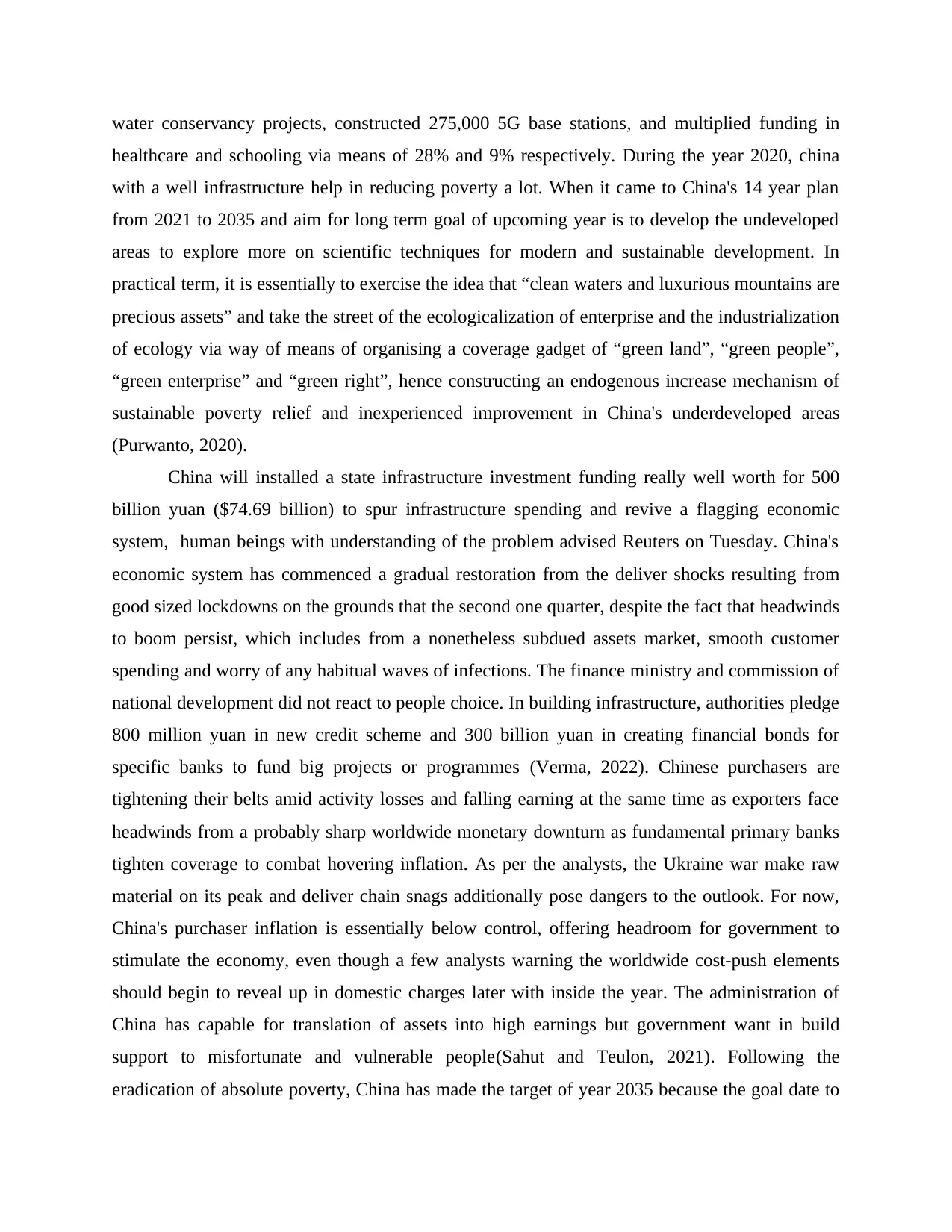
water conservancy projects, constructed 275,000 5G base stations, and multiplied funding in
healthcare and schooling via means of 28% and 9% respectively. During the year 2020, china
with a well infrastructure help in reducing poverty a lot. When it came to China's 14 year plan
from 2021 to 2035 and aim for long term goal of upcoming year is to develop the undeveloped
areas to explore more on scientific techniques for modern and sustainable development. In
practical term, it is essentially to exercise the idea that “clean waters and luxurious mountains are
precious assets” and take the street of the ecologicalization of enterprise and the industrialization
of ecology via way of means of organising a coverage gadget of “green land”, “green people”,
“green enterprise” and “green right”, hence constructing an endogenous increase mechanism of
sustainable poverty relief and inexperienced improvement in China's underdeveloped areas
(Purwanto, 2020).
China will installed a state infrastructure investment funding really well worth for 500
billion yuan ($74.69 billion) to spur infrastructure spending and revive a flagging economic
system, human beings with understanding of the problem advised Reuters on Tuesday. China's
economic system has commenced a gradual restoration from the deliver shocks resulting from
good sized lockdowns on the grounds that the second one quarter, despite the fact that headwinds
to boom persist, which includes from a nonetheless subdued assets market, smooth customer
spending and worry of any habitual waves of infections. The finance ministry and commission of
national development did not react to people choice. In building infrastructure, authorities pledge
800 million yuan in new credit scheme and 300 billion yuan in creating financial bonds for
specific banks to fund big projects or programmes (Verma, 2022). Chinese purchasers are
tightening their belts amid activity losses and falling earning at the same time as exporters face
headwinds from a probably sharp worldwide monetary downturn as fundamental primary banks
tighten coverage to combat hovering inflation. As per the analysts, the Ukraine war make raw
material on its peak and deliver chain snags additionally pose dangers to the outlook. For now,
China's purchaser inflation is essentially below control, offering headroom for government to
stimulate the economy, even though a few analysts warning the worldwide cost-push elements
should begin to reveal up in domestic charges later with inside the year. The administration of
China has capable for translation of assets into high earnings but government want in build
support to misfortunate and vulnerable people(Sahut and Teulon, 2021). Following the
eradication of absolute poverty, China has made the target of year 2035 because the goal date to
healthcare and schooling via means of 28% and 9% respectively. During the year 2020, china
with a well infrastructure help in reducing poverty a lot. When it came to China's 14 year plan
from 2021 to 2035 and aim for long term goal of upcoming year is to develop the undeveloped
areas to explore more on scientific techniques for modern and sustainable development. In
practical term, it is essentially to exercise the idea that “clean waters and luxurious mountains are
precious assets” and take the street of the ecologicalization of enterprise and the industrialization
of ecology via way of means of organising a coverage gadget of “green land”, “green people”,
“green enterprise” and “green right”, hence constructing an endogenous increase mechanism of
sustainable poverty relief and inexperienced improvement in China's underdeveloped areas
(Purwanto, 2020).
China will installed a state infrastructure investment funding really well worth for 500
billion yuan ($74.69 billion) to spur infrastructure spending and revive a flagging economic
system, human beings with understanding of the problem advised Reuters on Tuesday. China's
economic system has commenced a gradual restoration from the deliver shocks resulting from
good sized lockdowns on the grounds that the second one quarter, despite the fact that headwinds
to boom persist, which includes from a nonetheless subdued assets market, smooth customer
spending and worry of any habitual waves of infections. The finance ministry and commission of
national development did not react to people choice. In building infrastructure, authorities pledge
800 million yuan in new credit scheme and 300 billion yuan in creating financial bonds for
specific banks to fund big projects or programmes (Verma, 2022). Chinese purchasers are
tightening their belts amid activity losses and falling earning at the same time as exporters face
headwinds from a probably sharp worldwide monetary downturn as fundamental primary banks
tighten coverage to combat hovering inflation. As per the analysts, the Ukraine war make raw
material on its peak and deliver chain snags additionally pose dangers to the outlook. For now,
China's purchaser inflation is essentially below control, offering headroom for government to
stimulate the economy, even though a few analysts warning the worldwide cost-push elements
should begin to reveal up in domestic charges later with inside the year. The administration of
China has capable for translation of assets into high earnings but government want in build
support to misfortunate and vulnerable people(Sahut and Teulon, 2021). Following the
eradication of absolute poverty, China has made the target of year 2035 because the goal date to
⊘ This is a preview!⊘
Do you want full access?
Subscribe today to unlock all pages.

Trusted by 1+ million students worldwide
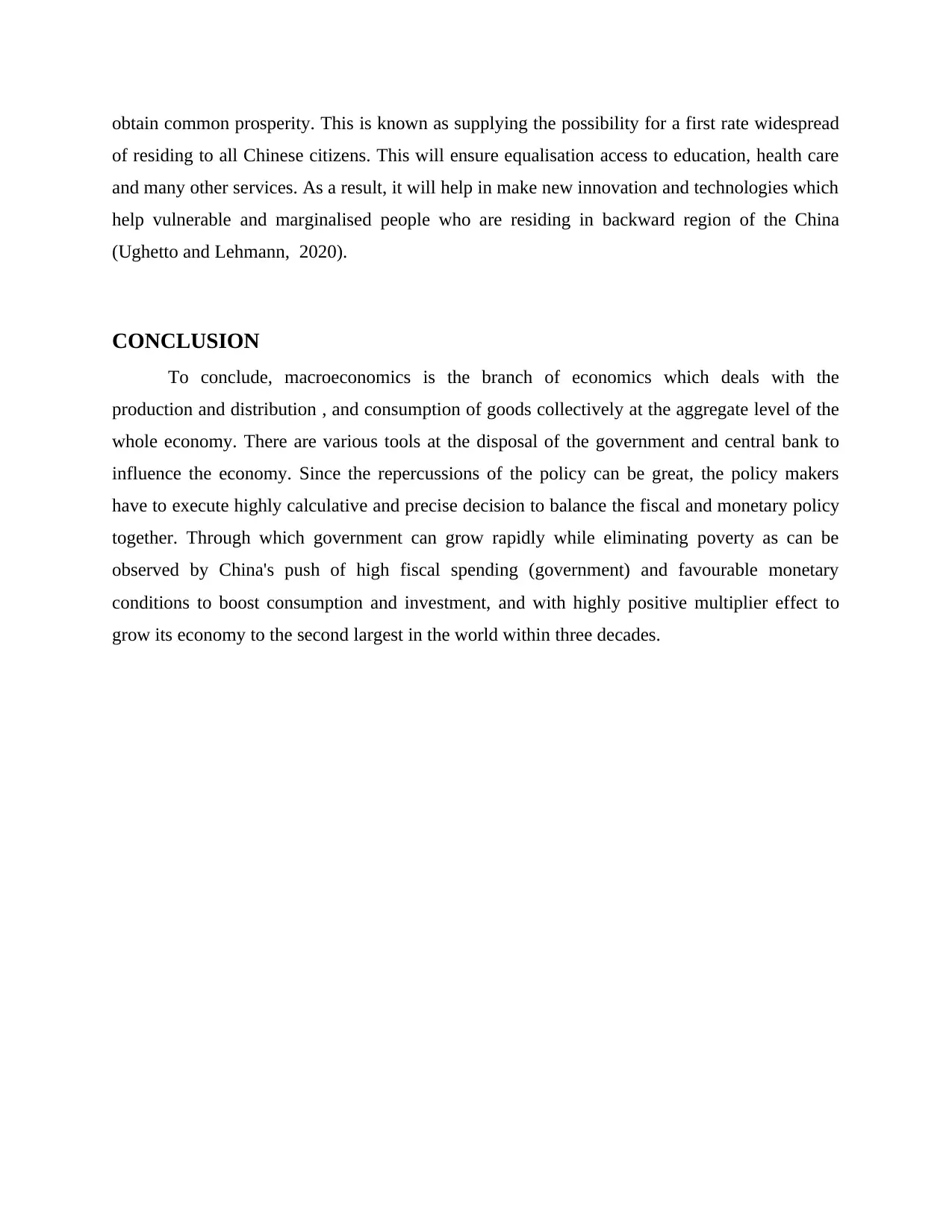
obtain common prosperity. This is known as supplying the possibility for a first rate widespread
of residing to all Chinese citizens. This will ensure equalisation access to education, health care
and many other services. As a result, it will help in make new innovation and technologies which
help vulnerable and marginalised people who are residing in backward region of the China
(Ughetto and Lehmann, 2020).
CONCLUSION
To conclude, macroeconomics is the branch of economics which deals with the
production and distribution , and consumption of goods collectively at the aggregate level of the
whole economy. There are various tools at the disposal of the government and central bank to
influence the economy. Since the repercussions of the policy can be great, the policy makers
have to execute highly calculative and precise decision to balance the fiscal and monetary policy
together. Through which government can grow rapidly while eliminating poverty as can be
observed by China's push of high fiscal spending (government) and favourable monetary
conditions to boost consumption and investment, and with highly positive multiplier effect to
grow its economy to the second largest in the world within three decades.
of residing to all Chinese citizens. This will ensure equalisation access to education, health care
and many other services. As a result, it will help in make new innovation and technologies which
help vulnerable and marginalised people who are residing in backward region of the China
(Ughetto and Lehmann, 2020).
CONCLUSION
To conclude, macroeconomics is the branch of economics which deals with the
production and distribution , and consumption of goods collectively at the aggregate level of the
whole economy. There are various tools at the disposal of the government and central bank to
influence the economy. Since the repercussions of the policy can be great, the policy makers
have to execute highly calculative and precise decision to balance the fiscal and monetary policy
together. Through which government can grow rapidly while eliminating poverty as can be
observed by China's push of high fiscal spending (government) and favourable monetary
conditions to boost consumption and investment, and with highly positive multiplier effect to
grow its economy to the second largest in the world within three decades.
Paraphrase This Document
Need a fresh take? Get an instant paraphrase of this document with our AI Paraphraser
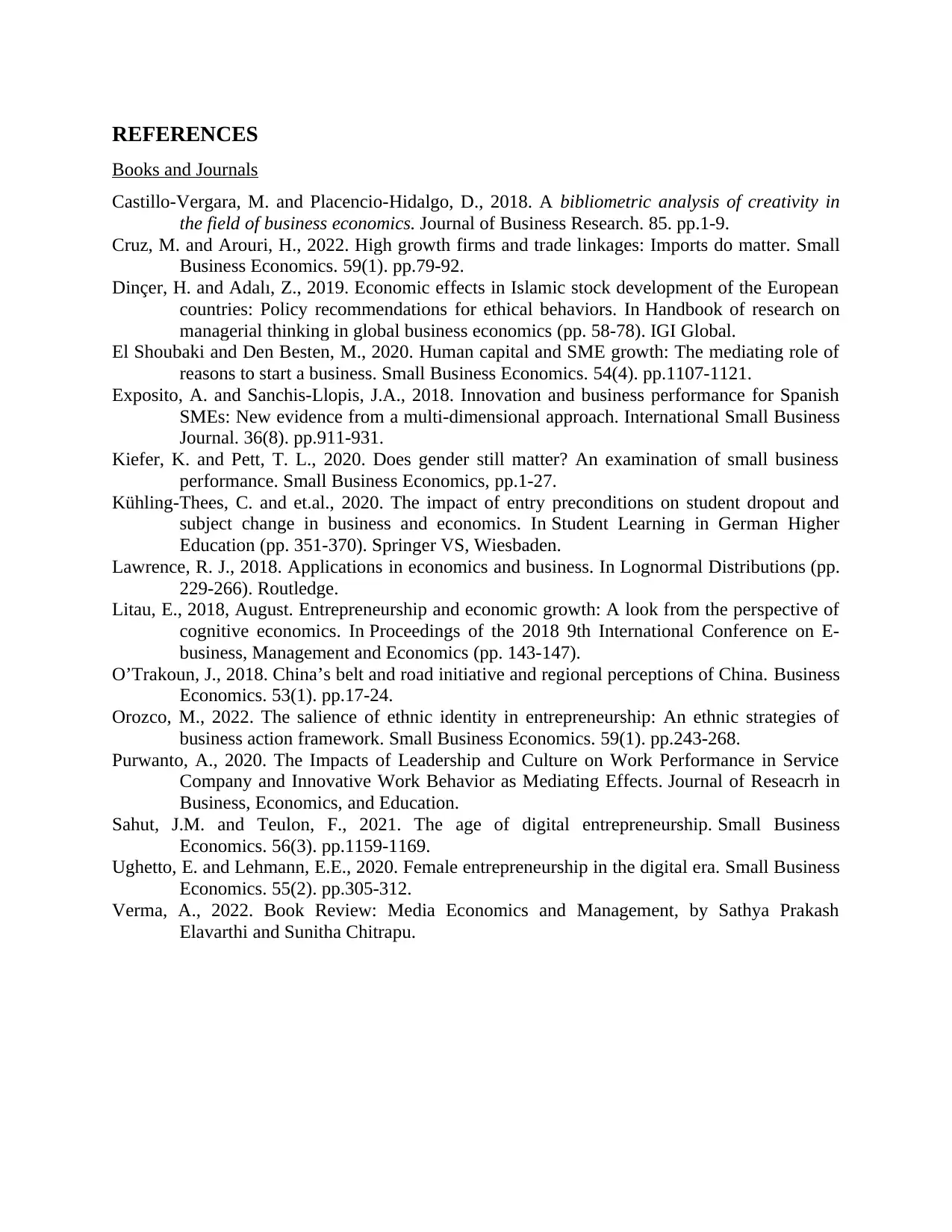
REFERENCES
Books and Journals
Castillo-Vergara, M. and Placencio-Hidalgo, D., 2018. A bibliometric analysis of creativity in
the field of business economics. Journal of Business Research. 85. pp.1-9.
Cruz, M. and Arouri, H., 2022. High growth firms and trade linkages: Imports do matter. Small
Business Economics. 59(1). pp.79-92.
Dinçer, H. and Adalı, Z., 2019. Economic effects in Islamic stock development of the European
countries: Policy recommendations for ethical behaviors. In Handbook of research on
managerial thinking in global business economics (pp. 58-78). IGI Global.
El Shoubaki and Den Besten, M., 2020. Human capital and SME growth: The mediating role of
reasons to start a business. Small Business Economics. 54(4). pp.1107-1121.
Exposito, A. and Sanchis-Llopis, J.A., 2018. Innovation and business performance for Spanish
SMEs: New evidence from a multi-dimensional approach. International Small Business
Journal. 36(8). pp.911-931.
Kiefer, K. and Pett, T. L., 2020. Does gender still matter? An examination of small business
performance. Small Business Economics, pp.1-27.
Kühling-Thees, C. and et.al., 2020. The impact of entry preconditions on student dropout and
subject change in business and economics. In Student Learning in German Higher
Education (pp. 351-370). Springer VS, Wiesbaden.
Lawrence, R. J., 2018. Applications in economics and business. In Lognormal Distributions (pp.
229-266). Routledge.
Litau, E., 2018, August. Entrepreneurship and economic growth: A look from the perspective of
cognitive economics. In Proceedings of the 2018 9th International Conference on E-
business, Management and Economics (pp. 143-147).
O’Trakoun, J., 2018. China’s belt and road initiative and regional perceptions of China. Business
Economics. 53(1). pp.17-24.
Orozco, M., 2022. The salience of ethnic identity in entrepreneurship: An ethnic strategies of
business action framework. Small Business Economics. 59(1). pp.243-268.
Purwanto, A., 2020. The Impacts of Leadership and Culture on Work Performance in Service
Company and Innovative Work Behavior as Mediating Effects. Journal of Reseacrh in
Business, Economics, and Education.
Sahut, J.M. and Teulon, F., 2021. The age of digital entrepreneurship. Small Business
Economics. 56(3). pp.1159-1169.
Ughetto, E. and Lehmann, E.E., 2020. Female entrepreneurship in the digital era. Small Business
Economics. 55(2). pp.305-312.
Verma, A., 2022. Book Review: Media Economics and Management, by Sathya Prakash
Elavarthi and Sunitha Chitrapu.
Books and Journals
Castillo-Vergara, M. and Placencio-Hidalgo, D., 2018. A bibliometric analysis of creativity in
the field of business economics. Journal of Business Research. 85. pp.1-9.
Cruz, M. and Arouri, H., 2022. High growth firms and trade linkages: Imports do matter. Small
Business Economics. 59(1). pp.79-92.
Dinçer, H. and Adalı, Z., 2019. Economic effects in Islamic stock development of the European
countries: Policy recommendations for ethical behaviors. In Handbook of research on
managerial thinking in global business economics (pp. 58-78). IGI Global.
El Shoubaki and Den Besten, M., 2020. Human capital and SME growth: The mediating role of
reasons to start a business. Small Business Economics. 54(4). pp.1107-1121.
Exposito, A. and Sanchis-Llopis, J.A., 2018. Innovation and business performance for Spanish
SMEs: New evidence from a multi-dimensional approach. International Small Business
Journal. 36(8). pp.911-931.
Kiefer, K. and Pett, T. L., 2020. Does gender still matter? An examination of small business
performance. Small Business Economics, pp.1-27.
Kühling-Thees, C. and et.al., 2020. The impact of entry preconditions on student dropout and
subject change in business and economics. In Student Learning in German Higher
Education (pp. 351-370). Springer VS, Wiesbaden.
Lawrence, R. J., 2018. Applications in economics and business. In Lognormal Distributions (pp.
229-266). Routledge.
Litau, E., 2018, August. Entrepreneurship and economic growth: A look from the perspective of
cognitive economics. In Proceedings of the 2018 9th International Conference on E-
business, Management and Economics (pp. 143-147).
O’Trakoun, J., 2018. China’s belt and road initiative and regional perceptions of China. Business
Economics. 53(1). pp.17-24.
Orozco, M., 2022. The salience of ethnic identity in entrepreneurship: An ethnic strategies of
business action framework. Small Business Economics. 59(1). pp.243-268.
Purwanto, A., 2020. The Impacts of Leadership and Culture on Work Performance in Service
Company and Innovative Work Behavior as Mediating Effects. Journal of Reseacrh in
Business, Economics, and Education.
Sahut, J.M. and Teulon, F., 2021. The age of digital entrepreneurship. Small Business
Economics. 56(3). pp.1159-1169.
Ughetto, E. and Lehmann, E.E., 2020. Female entrepreneurship in the digital era. Small Business
Economics. 55(2). pp.305-312.
Verma, A., 2022. Book Review: Media Economics and Management, by Sathya Prakash
Elavarthi and Sunitha Chitrapu.
1 out of 11
Related Documents
Your All-in-One AI-Powered Toolkit for Academic Success.
+13062052269
info@desklib.com
Available 24*7 on WhatsApp / Email
![[object Object]](/_next/static/media/star-bottom.7253800d.svg)
Unlock your academic potential
Copyright © 2020–2025 A2Z Services. All Rights Reserved. Developed and managed by ZUCOL.




